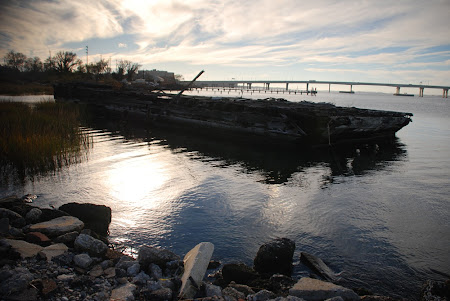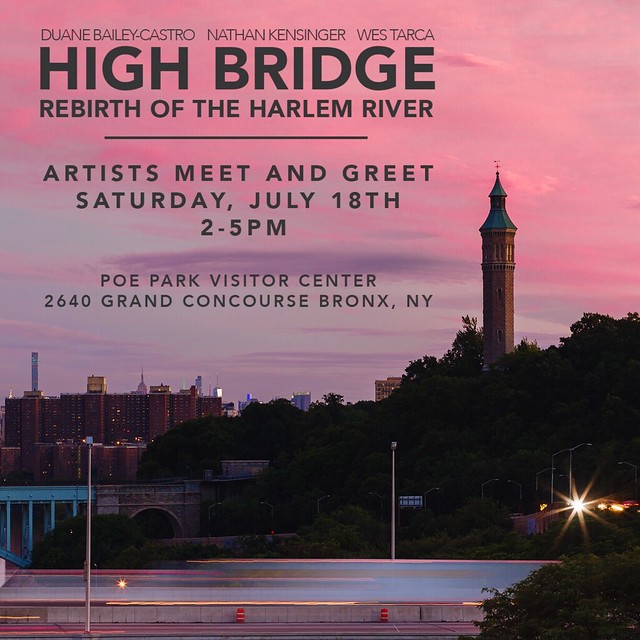Hammels Wye
 December 16, 2010 -
December 16, 2010 -
Hammels Wye is where the A train splits east and west along The Rockaways after crossing Jamaica Bay. Elevated trains rumble overhead through the surrounding neighborhood of Hammels, an area which was once crowded with grand hotels, restaurants and bungalows. Today, Hammels is pockmarked with empty lots and abandoned buildings, and dominated by the Hammel Houses, a 14-acre NYCHA housing development which is embroiled in a decades-old gang war with nearby complexes in Edgemere and Far Rockaway.
Hammels Wye sits in the shadow of the Hammel Houses. It is flanked by the shoreline of Jamaica Bay, where fenced-off blocks and empty beaches are covered in trash and abandoned boats. To the west, an undeveloped park sits on the water, covered with bricks and bottles. It was "sort of" opened in August 2010, according to The Wave, but currently the only access point is through a hole in a fence. On the east side of Hammels Wye, a solitary dead end street runs into the bay. The discarded remains of a young girl's bedroom rot in the middle of the road, while a nearby empty lot contains a reedy marshland the size of four city blocks. A faded sign promises that a new marina is on the way, but for now local fishermen must climb a fence to reach the water.
Between these empty spaces, Hammels contains few reminders of its past as an immensely popular resort village, which began in the 1850's with just "a small chowder house and saloon for boaters and fishermen on the bay," according to The Rockaways by Emil R. Lucev. The chowder house soon transformed into Eldert's Grove, a hotel and restaurant which was leased in 1869 by Louis Hammel, a German immigrant. Hammel purchased land nearby to build "Hammel's Hotel and a steamboat dock out to Jamaica Bay," according to The Rockaways. When the cross-bay train trestle was built in 1880, linking The Rockaways to the mainland, it landed at Hammel's Hotel, at a train station named for Hammel.
"Within a few years of the opening of the railroad, the real heart of Rockaway Beach became the Hammels-Holland-Seaside area," according to Old Rockaway, New York. "From its early beginnings in 1870 until about 1920, this section housed hotels, boardinghouses, saloons, rental-cottage colonies, stores, amusement arcades, restaurants, food stands, bathhouses, and all kinds of rides, from Ferris wheels to roller coasters." Huge tent cities were also created to house vacationers, and in 1908 over 40,000 spectators came out for a parade celebrating the "King and Queen of the Tent City carnival," according to the NY Times, in which "the prettiest girls of Tent City" rode in a float "drawn by six white horses" in a parade that ended in Hammels.
These same streets are now largely deserted. "The bay side of Hammels was filled with long rows of summer facilities for fishermen and summer renters," according to The Rockaways by Emil R. Lucev, but "over the last century, storms and fire have reduced the bay front clusters to a handful on the west side of the bay trestle. These are surrounded by empty pile foundations standing upright in the bay waters." Despite the isolation, one resident living on the shore near Hammels Wye described his home as a "ghetto paradise," complete with private beach, dog run, and panoramic views of the Cross Bay Bridge. Next to his new home stood four old summer bungalows, built on pilings above the bay and shuttered for the winter season.
The Rockaways gradually declined in popularity as a vacation destination, and "by the 1930's, a sizeable section of Hammels a block or two away from the beach already consisted of substandard housing," according to Between Ocean and City by Lawrence and Carol Kaplan. Newspapers referred to this area as "slum town" and "not surprisingly, health officials were alarmed by the growing rate of tuberculosis in Hammels, which was now said the be the highest in all of New York City." Like Edgemere, much of Hammels' summer bungalows were demolished during in the Robert Moses era. Some land was used to build the Hammel Houses, which opened in 1955 and now have over 1,900 residents. However, the "low-income developments in the Rockaways contributed to the expansion of residential decay... Instead of ending the dreadful conditions that had existed for decades, the projects served, indirectly, to expand them," according to Between Ocean and City.
Today, the Hammel Houses are engaged in "a gang war between housing projects," as reported in the NY Times, which stretches back for decades. The complex is also in conflict with the nearby residents of Arverne By The Sea, a massive new beachfront community located just across the street. Arverne has been described as "New York City’s newest and most improbable neighborhood" by New York Magazine, perhaps partially due to its proximity to the violent Hammel Houses. In 2007, a local councilman accused Arverne developers of “trying to build a self-contained city,” according to the NY Times, "while ignoring the surrounding community and its ills: unemployment, gangs, guns, drugs and troubled schools." In the process, he claimed, "they’re creating the conditions for a perfect storm of racial discontent and possibly more violence." As recently as October 2010, Arverne residents were reporting "being pelted with rocks from Hammels," according to The Wave, prompting one commenter to ask "who in their right mind would pay hundreds of thousands of dollars to buy a house or condo in the Hammels area and not expect to be vandalized in one of the worst crime areas in the country?"
In the meantime, the omnipresent trains of Hammels Wye trundle along overhead, past the boarded up remains of a forgotten era. Their schedule is as regular as the tides of Jamaica Bay, and as ceaseless as the decay of The Rockaways.
---
For more photo essays from The Rockaways, please visit The North Edgemere Shore (2010) The South Edgemere Wasteland (2010), The Edgemere Landfill (2010) and Far Rockaway: Abandoned Bungalows (2009).


























great, lyrical post. It seems you are lamenting a by gone era...what do you think should be done with the area now?
ReplyDeleteI love the Rockaway series. Your photo essays are always so good and enlightening.
ReplyDeleteHammels Wye....some of your photos and even the name suggests 17th or 18th century England.
ReplyDeleteNot really... a wye is just a three way railroad track interconnection. Certainly you mean late 19th century?
ReplyDeleteGreat piece Nathan. I used to ride through this area a couple of years ago when I was staying in one the bungalows out in Far Rockaway. I used to wonder what was out there. it seems like an entire forgotten neighborhood, festering just a short walk from the sea. The Rockaways are such a curious place - the feeling of being cut off when I stayed there was overwhelming and I'm sure it hasn't gotten better.
ReplyDeleteT.
When I see images like this, I can't help but imagine that some of the people I see during my daily subway commute in Manhattan may live in such mysterious areas.
ReplyDeleteIs so sad to be living around the area that look so crappy and scary looking.
ReplyDeletei grew up there--8600 shore front pky--in the dayton towers--on 86st, which had terraced apts, and inground Olympic-sized swimming pools. I had friends in
ReplyDeletethe hammel projects.
i learned to fish at the sites shown. There was an older crossbay bridge,
which had really good fishing--and a bait store right near it.
we were almost right on the beach, had a great boardwalk, a nice amusement park--rockaways playland by the sea.
the beach had stone jetties and great striped bass fishing from them.
i often fished there at 4am.
the schools were excellent--j.h.s. 180 and its gifted s.p. program was my
stepping stone to the bronx high school of science.
i would not trade my 1960's rockaway childhood. it was wonderful.